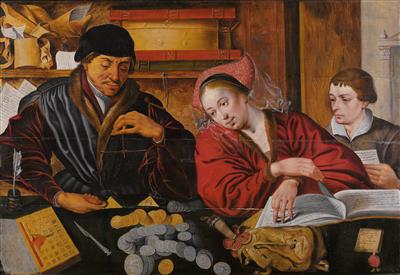Circle of Marinus van Reymerswaele

(Reimerswaal circa 1490 - circa 1546)
The Moneychanger and his Wife
oil on panel, 72 x 105 cm, framed
Provenance:
European Private Collection
The present painting is based on Marinus van Reymerswaele’s composition of the Moneychanger and his Wife, which has come down to us in numerous versions, such as in Dresden (Gemäldegalerie Alte Meister), Florence (Museo Nazionale del Bargello), Munich (Alte Pinakothek), Madrid (Museo del Prado), and St. Petersburg (Hermitage). In terms of composition, the present painting, which unlike most variants renders the table in the foreground with an extreme view from above, is particularly close to the versions in Antwerp (Koninklijk Museum voor Schone Kunsten), Copenhagen (Statens Museum for Kunst), and Valenciennes (Musée des Beaux-Arts), to all of which a third person has similarly been added at the right margin.
Inscriptions on the documents that Marinus van Reymerswaele integrated into several versions of the composition identify the figures depicted as tax farmers. Since they collected taxes for a town while keeping parts of the revenue for themselves, they did not enjoy a particularly good reputation among the population, as is evidenced by numerous contemporary texts. It therefore seems that Marinus’ composition should be interpreted as a criticism of avarice: with regard to both composition and motif, it is based on the painting the Moneychanger and His Wife by Quinten Massys from 1514 (Paris, Musée de Louvre), yet Marinus has replaced the prayer book with an account book, the pages of which the moneychanger’s wife turns with pointed fingers; to the objects depicted on the table, the artist has added the motifs of a money pouch and a wooden casket holding the scales for weighing the coins (utensils then associated with the deadly sin of avaritia). It is thus not surprising that one version of the composition – probably the one now in the Prado, which dates from 1539 – was described as a depiction of ‘avarice, symbolised by a man and a woman counting money’ in the 18th century (see A. Ponz, Viage de España, vol. VI, Madrid, 1782, p. 151).
20.10.2015 - 18:00
- Realized price: **
-
EUR 37,500.-
- Estimate:
-
EUR 30,000.- to EUR 40,000.-
Circle of Marinus van Reymerswaele
(Reimerswaal circa 1490 - circa 1546)
The Moneychanger and his Wife
oil on panel, 72 x 105 cm, framed
Provenance:
European Private Collection
The present painting is based on Marinus van Reymerswaele’s composition of the Moneychanger and his Wife, which has come down to us in numerous versions, such as in Dresden (Gemäldegalerie Alte Meister), Florence (Museo Nazionale del Bargello), Munich (Alte Pinakothek), Madrid (Museo del Prado), and St. Petersburg (Hermitage). In terms of composition, the present painting, which unlike most variants renders the table in the foreground with an extreme view from above, is particularly close to the versions in Antwerp (Koninklijk Museum voor Schone Kunsten), Copenhagen (Statens Museum for Kunst), and Valenciennes (Musée des Beaux-Arts), to all of which a third person has similarly been added at the right margin.
Inscriptions on the documents that Marinus van Reymerswaele integrated into several versions of the composition identify the figures depicted as tax farmers. Since they collected taxes for a town while keeping parts of the revenue for themselves, they did not enjoy a particularly good reputation among the population, as is evidenced by numerous contemporary texts. It therefore seems that Marinus’ composition should be interpreted as a criticism of avarice: with regard to both composition and motif, it is based on the painting the Moneychanger and His Wife by Quinten Massys from 1514 (Paris, Musée de Louvre), yet Marinus has replaced the prayer book with an account book, the pages of which the moneychanger’s wife turns with pointed fingers; to the objects depicted on the table, the artist has added the motifs of a money pouch and a wooden casket holding the scales for weighing the coins (utensils then associated with the deadly sin of avaritia). It is thus not surprising that one version of the composition – probably the one now in the Prado, which dates from 1539 – was described as a depiction of ‘avarice, symbolised by a man and a woman counting money’ in the 18th century (see A. Ponz, Viage de España, vol. VI, Madrid, 1782, p. 151).
|
Buyers hotline
Mon.-Fri.: 10.00am - 5.00pm
old.masters@dorotheum.at +43 1 515 60 403 |
| Auction: | Old Master Paintings |
| Auction type: | Saleroom auction |
| Date: | 20.10.2015 - 18:00 |
| Location: | Vienna | Palais Dorotheum |
| Exhibition: | 10.10. - 20.10.2015 |
** Purchase price incl. charges and taxes
It is not possible to turn in online buying orders anymore. The auction is in preparation or has been executed already.
